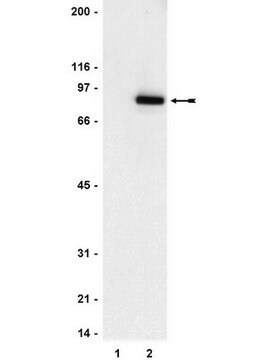MABF2817
Anti-SARS-CoV-2 nucleocapsid NC1 Antibody, clone 6G3-G6
Synonym(s):
Nucleoprotein (UniProt: P0DTC9;also known as N;Nucleocapsid protein;NC;Protein N
About This Item
Recommended Products
biological source
mouse
Quality Level
conjugate
unconjugated
antibody form
purified antibody
antibody product type
primary antibodies
clone
6G3-G6, monoclonal
mol wt
calculated mol wt 45.63 kDa
observed mol wt ~50 kDa
purified by
using protein G
species reactivity
SARS coronavirus
packaging
antibody small pack of 100 μg
technique(s)
immunocytochemistry: suitable
immunoprecipitation (IP): suitable
western blot: suitable
isotype
IgG1κ
epitope sequence
N-terminal half
Protein ID accession no.
UniProt accession no.
shipped in
ambient
target post-translational modification
unmodified
Gene Information
human ... GINS1(9837)
General description
Specificity
Immunogen
Application
Evaluated by Western Blotting in lysate from HEK293T cells expressing SARS-CoV-2-Nucleocapsid NC1 protein.
Western Blotting Analysis (WB): A 1:1,000 dilution of this antibody detected Nucleoprotein NC1 in lysate from HEK293T cells expressing SARS-CoV-2 nucleocapsid NC1, but not in lysates from wild-type HEK293T cells or from HEK293T cells expressing the Spike protein.
Tested Applications
Western Blotting Analysis: A 1:2,000 dilution from a representative lot detected Nucleoprotein in Whole cell lysates of HEK293T expressing the nucleocapsid (NC) proteins of the indicated human coronaviruses (Data courtesy of Dr. Stefan Schüchner, Dr. Egon Ogris, Max Perutz Labs, Medical University of Vienna, Austria).
Immunocytochemistry Analysis: A representative lot detected Nucleoprotein in HeLa cells transiently transfected with SARS-CoV-2 NC-P2A-GFP (Data courtesy of Dr. Stefan Schüchner, Dr. Egon Ogris, Max Perutz Labs, Medical University of Vienna, Austria).
Immunoprecipitation Analysis: A representative lot detected Nucleoprotein in with the indicated monoclonal antibodies from whole cell lysate of HEK293T cells expressing Sars-CoV-2-NC-P2A GFP (Data courtesy of Dr. Stefan Schüchner, Dr. Egon Ogris, Max Perutz Labs, Medical University of Vienna, Austria).
Note: Actual optimal working dilutions must be determined by end user as specimens, and experimental conditions may vary with the end user
Physical form
Storage and Stability
Other Notes
Disclaimer
Not finding the right product?
Try our Product Selector Tool.
recommended
Storage Class Code
12 - Non Combustible Liquids
WGK
WGK 1
Certificates of Analysis (COA)
Search for Certificates of Analysis (COA) by entering the products Lot/Batch Number. Lot and Batch Numbers can be found on a product’s label following the words ‘Lot’ or ‘Batch’.
Already Own This Product?
Find documentation for the products that you have recently purchased in the Document Library.
Our team of scientists has experience in all areas of research including Life Science, Material Science, Chemical Synthesis, Chromatography, Analytical and many others.
Contact Technical Service






